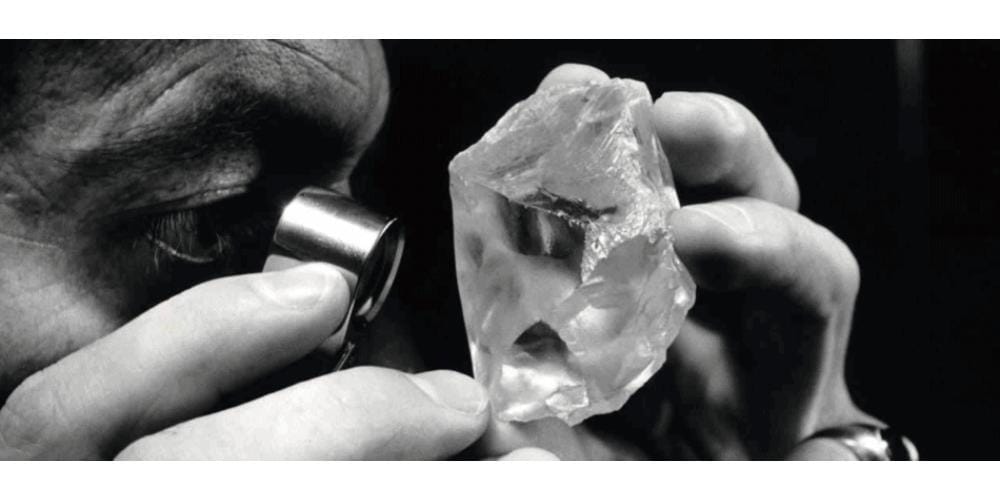For centuries, diamonds have been of high value. They represent wealth, beauty, and love. Not all diamonds, however, are identical. A diamond begins as a crude stone before becoming the brilliant jewel in a ring or pendant.
Knowing how rough diamonds are graded and mined will enable you to value their trip from mine to masterpiece. This blog will discuss how experts assess the quality of rough diamonds and the steps of their sourcing.
What Does Rough Diamond Sourcing Mean?
Finding and buying uncut diamonds straight from mines or traders defines rough diamond sourcing. Frequently in isolated locations, these raw stones are extracted from the ground. Among the main diamond-producing countries are Canada, South Africa, Russia, and Botswana.
Get a wholesale rough diamond distributor for reliable and affordable purchases.
How Rough Diamonds Are Mined?
Diamonds are usually mined in one of two basic ways:
Open-pit Mining: Massive pits are built in places where diamonds are near the surface. To reach the deposits, miners strip away layers of earth.
Deep tunnels are created to access diamond-bearing rock deeper underground.
Once mined, the rough diamonds are sorted and sold to diamond corporations or dealers. They occasionally engage in direct sales or auctions.
Difficulties With Procurement
Getting rough diamonds requires traversing difficult logistical issues, addressing moral and political questions, and making sure the stones are conflict-free. Stones mined in war zones or under immoral circumstances are known as “conflict diamonds” or “blood diamonds“. Certifications such as the Kimberley Process guarantee that diamonds are ethically obtained.
The Way from Mine to Market
Usually undergoing multiple stages after sourcing, rough diamonds reach the customer:
- Expert sort and grade the rough diamonds by looking at their color, shape, and quality as well as their size.
- Cutting and Polishing: Expert craftsmen carve the raw into perfected gems.
- Polished diamonds are used for jewelry pieces for sale.
- Every phase calls for accuracy and mastery. But before any of this, grading the rough stone is vital.
- Rough diamond is graded on several criteria.
Grading rough diamonds helps guide their cutting method and assess their worth. Unlike finished diamonds, rough stones are not always perfectly clear or symmetrical; hence, grading depends on particular criteria.
Main Elements in Grading Rough Diamonds
Carat Weight
This measures the size of the stone. Larger rough diamonds are generally more valuable, but size alone doesn’t determine worth. Get good carat weight from Bunia rough diamond mining Company, for a reliable purchase.
Color
Color For rough stones, the color is evaluated according to how it impacts the ultimate gem’s possible quality.
Clarity
Clarity is related to internal inclusions or exterior imperfections. In rough diamonds, inclusions can affect whether the stone is appropriate for particular cuts or whether it demands special care.
Form and Shape
The form naturally influences how the diamond can be cut. Certain crude stones are more symmetrical, which makes them simpler to cut effectively.
Diamond Type
Based on their chemical makeup, diamonds come in several forms. This could have been born on their cut and worth.
Detailed Grading Method
Visual Inspection
Experts first use magnification tools and the naked eye to examine the raw diamond. They look for apparent faults, color bands, and general form.
Use of Technology
Advanced equipment, including X-ray cameras, laser scanners, and 3D imaging, enables evaluation of interior characteristics and the possible yield following incision.
Calculating the Ultimate Cut
Graders examine the rough to find the most appropriate cut. Deciding whether to shape the diamond into a round, princess, or other extravagant shape to maximize its worth is part of this.
Calculating Value and Yield
Not all rough diamonds may be cut into premium gems. Some might be more appropriate for manufacturing or smaller jewelry designs. The aim is to project the “yield,” or the proportion of the rough that will become a pleasing finished stone.
Why Grading Is Crucial?
Grading rough diamonds guides merchants, cutters, and jewelers in evaluating the possible worth of every stone and its optimum application. It guarantees openness in the market as well; therefore, consumers are aware of what they are buying.
How much a rough diamond will sell for can also be affected by appropriate grading. A big, high-quality rough stone with few faults would often command a higher price, for instance.
Ethical Factors in Grading and Sourcing
Ethical sourcing has posed challenges for the diamond industry. Today’s customers want to make sure their diamonds are morally mined and conflict-free. Programs for certification, such as the Kimberley Process, assist in confirming that diamonds are obtained ethically.
Many businesses today engage in open supply chains or cooperate directly with mines. They also provide certification and meticulous grading to ensure ethical requirements and quality.
Final Thoughts
Developments in technology are enabling more precise and open sourcing and grading processes. Non-invasive scanning and digital grading instruments enable improved evaluation without harming the stones.
Furthermore, providing clear provenance alternatives, the development of lab-grown diamonds helps. Though made in regulated circumstances, these stones are ranked alike, hence lowering ethical issues.
Turning a raw stone into exquisite jewelry depends on careful rough diamond sourcing and grading, which are crucial steps. Sourcing entails delicate extraction from mines, sometimes with ethical and environmental considerations in mind. Grading helps, on the other hand, to assess the possible worth and the perfect manner to cut the diamond.
Appreciating these processes helps us to better value the workmanship and attention put into presenting a glittering diamond from far beneath the earth to your jewelry box. Understanding how rough diamonds are gathered and classified gives depth to your respect for these valuable stones, whether you are a buyer, seller, or fan.
Bulk Rough diamond supplier is available at Bunia Metals Group to assist with your diamond requirements.




